by Eric Gibson
We’ve all heard of termites the pesky insects that cause $5 billion in property damage each year. But termites aren’t the only wood-destroying organisms that you have to watch out for. Powderpost Beetles will also tunnel into the wood of your home and furniture. Although both pests require professional treatments, it is important to identify the pest problem as one or the other, as treatment options for the two differ greatly.
Before we get into treatment options, it’s best to familiarize yourself with the proper identification of these two wood-destroying organisms.
Powderpost Beetles
It’s the Powderpost larvae that do most the damage. White and C-shaped, the larvae live in and consume wood. Like all types of insects, there are different families within the order. With Powderpost Beetles, there are three common families you have to look out for: Anobiid, Bostrichid and Lyctid. Here are some characteristics of each family:
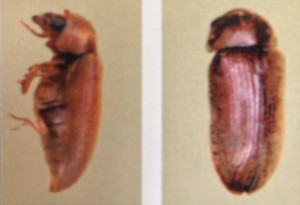 1/16 to 1/4 inch long and reddish brown or grayish brown to dark brown.
1/16 to 1/4 inch long and reddish brown or grayish brown to dark brown.- Cylindrical body, elongated and covered with fine hair
- Head covered by pronotum
- Larvae are white, c-shaped with rows of small spines on the dorsal side.
- Life cycle: 1-10 years.
- Infest seasoned softwood and the sapwood of seasoned hardwoods.
- Prefer high moisture content in poorly ventilated areas in crawl spaces of houses, utility rooms, and garages.
- Signs of Infestation:Damage done by larvae under the surface. But emergence holes made by adults leaving the wood and powderlike frass. Emergence holds 1/16 to 1/8 inch in diameter and round. Cigar-shaped frass found in tunnels.
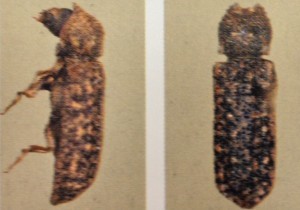 1/8 to 3/4 inch long and reddish brown to black. Elongated bodies and cylindrical with roughened thorax.
1/8 to 3/4 inch long and reddish brown to black. Elongated bodies and cylindrical with roughened thorax.- Heads are concealed by the pronotum.
- Short, sawtoothed antennae.
- Life cycle one year.
- Larvae C-shaped with no spines on body.
- Infest seasoned softwood and hardwood, esp. unfinished floors, window sills, and furniture. Bamboo esp. susceptible.
- Signs of Infestation:the round emergence holes are 1/8 to 3/16 inch in diameter. Sawdustike frass sticks together and is tightly packed in galleries, but not in entrance holes.
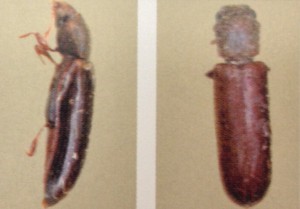 ¼ inch long and brown. Elongated body and slightly
¼ inch long and brown. Elongated body and slightly- Head not covered by pronotum.
- Antennae have a two-segmented terminal club.
- Larvae are white and C-shaped
- Life cycle: 6 months – 4 years
- Infest sapwoods of hardwoods, mainly ash, hickory, oak, maple and mahogany. Most found in wood paneling, molding, window and door frames, hardwood floors, and furniture. Rarely infest wood older than 5 years. Usually found in new homes.
- Infestation usually occurs from wood that contained eggs or larvae when purchased.
Controlling Powderpost Beetles
Selecting the best control method depends upon the severity of the infestation, the location, the potential for reinfestation and, of course, the cost of the treatment. But unlike with termites, you have plenty of time to decide upon your treatment options because beetles destroy wood slowly.
Prevention
Inspect all of the wood that you bring into house (furniture) to insure that the wood is not infested with larvae. Applying wood finishes to furniture does wonders with beetle prevention because beetles will ONLY lay eggs on bare, unfinished wood. Beetles will not infest pained, varnished or waxed wood. Coating wood with a finish can also prevent re-infestation.
If you find that a piece of wood is infested, but not the whole structure, you will want to replace that piece. For example, if an emergence hole appears in a door or window frame, the piece can be removed and replaced. Also, you can use a good surface treatment (insecticide) to coat the bare wood. This will create a barrier, and kill all beetles as they chew their way out. For the treatment to work, it needs to penetrate the wood. So, sand the finish before applying.
The most effective method of control for wood-boring beetles, as well as being the most costly, is fumigation. Only a Pest Control Certified Professional can conduct a fumigation. You may not have to tent the whole house if the infestation is localized and limited to a piece of furniture. You can fumigate single pieces of furniture in a Pest Control Professional’s fumigation vault.
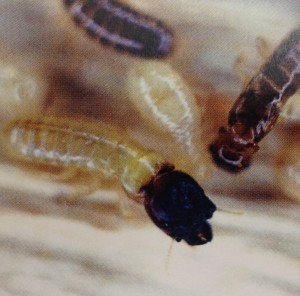 Six-sided fecal pellets, known as
Six-sided fecal pellets, known as 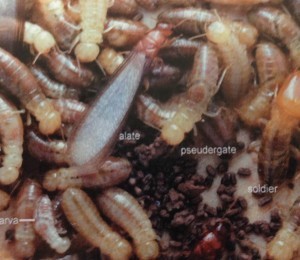 frass. Come out of “kickout holes” 1 to 2 mm in diameter. Look like sawdust or coffee grounds but no relation to the color of the wood the termites are feeding. Gritty texture. Light tan to almost black.
frass. Come out of “kickout holes” 1 to 2 mm in diameter. Look like sawdust or coffee grounds but no relation to the color of the wood the termites are feeding. Gritty texture. Light tan to almost black.- Blistering occurs when termites tunnel just underneath surface.
- Tap screw driver on wood and listen for a hollow, papery, rustling sound.
- Multiple colonies can be in one structure.
- Do not produce mud tubes or create visible open holes in the wood. Plug holes with fecal matter to prevent themselves from drying out.
- Fecal pellets may be found in infested structures and will be found stuck to the sides of the galleries, usually forming clumps.
- May find wings of swarmers.
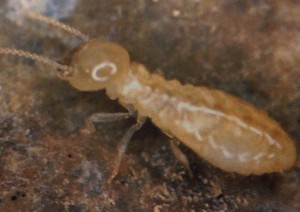 Hard to detect since nest underground.
Hard to detect since nest underground.- Build mud tubes that connect the ground to the wood.
- Tap the wood to determine galleries.
- Do not push frass outside of wood.
The two biggest determining factors in identifying the type of Wood-destroying Organism is frass (termites) and emergence holes (beetles).
As with all pest-related identification, it’s best to have a pest control professional come out for a free inspection. A pest inspector will inspect the damage and the frass or wings and properly identify the pest and offer the best treatment option for your home.

Pingback: online games
After treatment with CCA can powder post beetles still attacking the timbers. During treatment process do larva and eggs get killed and destroyed.
Excellent information for homeowners especially in the Central Florida area.